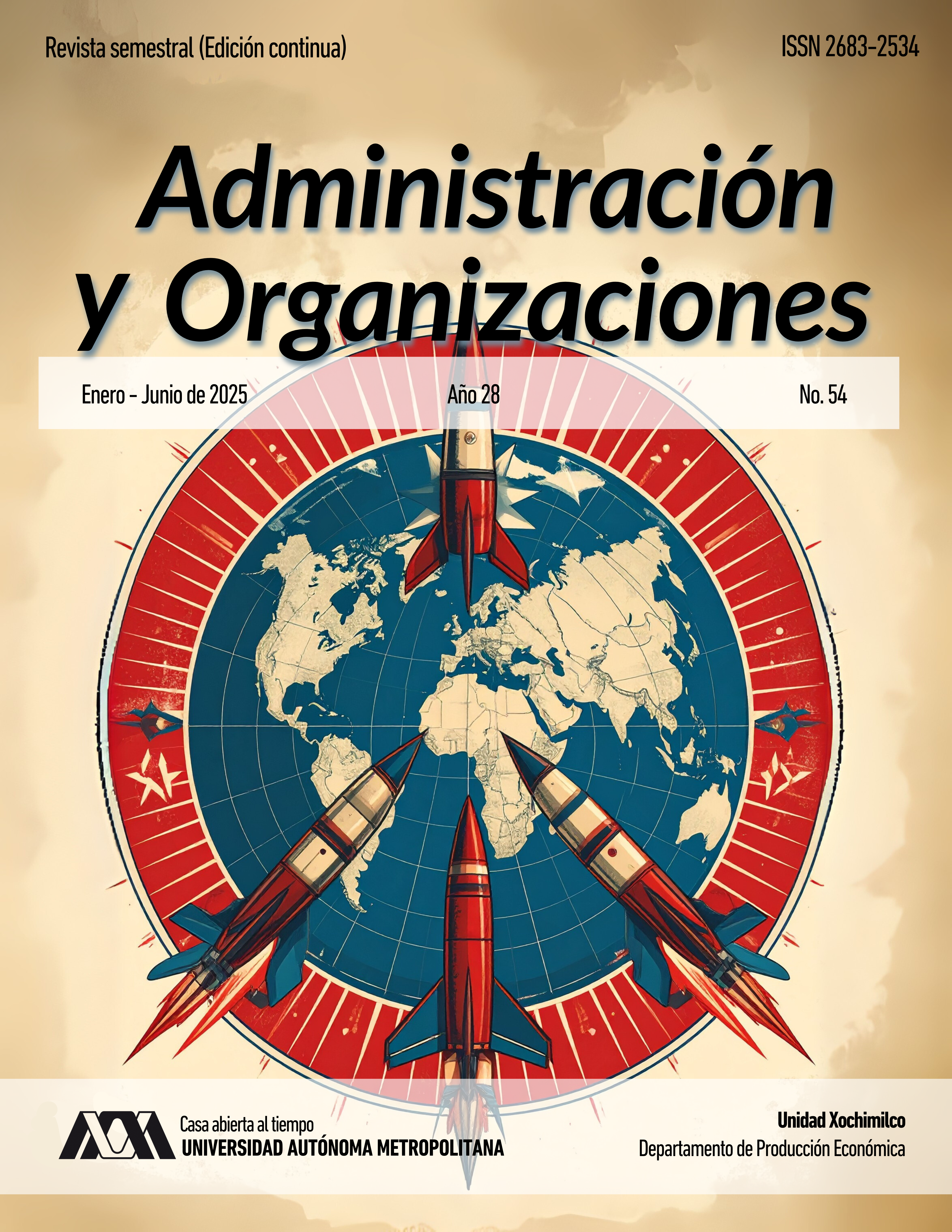Satisfaction level of Undergraduate University Students Before and During the Covid-19 Pandemic
DOI:
https://doi.org/10.24275/HUKW5229Keywords:
Protección del consumidor, Centros de enseñanza superior y de investigación, calidad de la educación, PandemiaAbstract
Satisfaction is a central concept in the field of consumer behavior, since it is considered as a measure of the quality of products and services. The aim of this study is to know the evolution of students’ satisfaction with educational services provided by the university, previously and during the Covid-19 pandemic, taking as a basis the cumulative satisfaction approach and from an strategic perspective. An ex-post factor, quantitative, longitudinal research was designed. Information was gathered in 2018 and 2021 from samples of 618 and 596 undergraduate students respectively. A comparison of the means for both periods revealed a statistically significant difference. In conclusion, the usefulness, for educational organizations, of measuring students' satisfaction as an indicator of quality and as a means to get a competitive advantage, is supported.
Downloads
References
Anderson, R. E. (1973). Consumer disatisfaction: The effect of disconfirmed expectancy on perceived product performance. Journal of Marketing Research, 10, 38-44. https://doi.org/10.2307/3149407
Anderson, E. W. y Fornell, C. (2000) Foundations of the American Customer Satisfaction Index. Total Quality Management, 11(7), 869-882. https://doi.org/10.1080/09544120050135425
Cardozo, R. (1965). An Experimental Study of Customer Effort, Expectation, and Satisfaction. Journal of Marketing Research, 2, 244-249. https://doi.org/10.2307/3150182
Cortés-Rodríguez, N. C. (2014). Implicaciones de las emociones en la evaluación de la calidad y satisfacción de los servicios universitarios: una experiencia de caso con estudiantes. Sotavento M.B.A., (24), 126–135. Recuperado a partir de https://revistas.uexternado.edu.co/index.php/sotavento/article/view/4061
Churchill. G. y Suprenant, C. (1982). An investigation into determinants of customer satisfaction. Journal of Marketing Research, 19, 491-504. https://doi.org/10.1177/002224378201900410
Fornell, C., Rust, R. T., Dekimmpe, M. G. (2010). The effect of customer satisfaction on spending on Consumer Spending Growth. Journal of Marketing Research, 47(1), 28-35. http://www.jstor.org/stable/20618952
Fornell, C., Johnson, M. D., Anderson, E. W. Cha, J. y Bryant, B. E. (1996). The American Customer Satisfaction Index: Nature, Purpose, and Findings. Journal of Marketing, 60, 7-18. https://doi.org/10.1177/002224299606000403
Fornell, C. (1992). A National Customer Satisfaction Barometer: The Swedish Experience. Journal of Marketing, 56, 6-21. https://doi.org/10.1177/002224299205600103
Gao, B., Ding, X., Chen, W., Jiang, X., y Wu, J. (2020). When online reviews meet ACSI: how ACSI moderates the effects of online reviews on hotel revenue. Journal of Travel & Tourism Marketing, 37(3), 396–408. https://doi.org/10.1080/10548408.2020.1767261.
Giese, J. L. y Cote, J. A. (2000). Defining consumer satisfaction. Academy of Marketing Science Review, 1, 1-34.
Gustafsson, A. y Johnson, M. D. (1997). “Bridging the quality-Satisfaction Gap. Quality management Journal, 4(3), 27-43 https://doi.org/10.1080/10686967.1997.11918801
Howard, J. A. y Sheth, J. N. (1969). The theory of buyer behavior. John Wiley & Sons, Inc.
Jing, H., y Zhichao, Y. (2021). An Empirical Study on Higher Vocational Students’ Satisfaction with Online Courses based on ACSI Model. 2021 International Conference on Education, Information Management and Service Science (EIMSS), Education, Information Management and Service Science (EIMSS), 2021 International Conference on, EIMSS, 94–98. https://doi.org/10.1109/EIMSS53851.2021.00029
Johnson, M. D. y Fornell, C. (1991). A Framework for Comparing Customer Satisfaction Across Individuals and Product Categories. Journal of Economic Psychology, 12(2), 267-286. https://doi.org/10.1016/0167-4870(91)90016-M
Johnson, M.D. y Gustafsson, A. (1997). Bridging the gap II: Measuring and Prioritizing Customer Needs” en A. Gustafsson, B. Bergman and F. Ekdahl (eds). Proceedings of the Third Annual International QFD Symposium, 2, 21-34
Johnson, M. D., Gustafsson, A. y Cha, J. (1998). The Evolution and Future of National Customer Satisfaction Index Models. Service Research Center. Research Report 98(4), 1-63. https://doi.org/10.1016/S0167-4870(01)00030-7
Kerlinger, F. y Lee, H. B. (2002) Investigación del Comportamiento. Métodos de Investigación en Ciencias Sociales, McGraw-Hill.
Krejnus, M., Repková Štofková, K., Štofková, J., Štofková, Z., Loučanová, E., Poliaková, A., y Šujanská, L. (2024). Measuring Efficiency and Satisfaction in the Context of Digital Transformation. Administrative Sciences (2076-3387), 14(9), 217. https://doi.org/10.3390/admsci14090217
Liu, M., Chen, W., y Yang, L. (2022). Optimization of Experimental Teaching System based on ACSI Model. 2022 International Conference on Information System, Computing and Educational Technology (ICISCET), 106–109. https://doi.org/10.1109/ICISCET56785.2022.00035
Ma, Y., Xu, G., Li, J., y Xie, E. (2020). The Influence Factors Analysis of Instructional Interaction on College Students’ Satisfaction in Online Education based on the ACSI Model. 2020 International Conference on Information Science and Education (ICISE) 219–222. https://doi.org/10.1109/ICISE51755.2020.00054
Marcano, P. y Uribe, A. (2022). Satisfacción estudiantil como un indicador de la calidad educativa. Revista Ciencias Pedagógicas e Innovación, 10(1), 79-84. https://doi.org/10.26423/rcpi.v10i1.520
Moral, I. (2006). Comparación de medias en Métodos estadísticos para enfermería Nefrológica, A. Guillen y R. Crespo. pp. 165-184. Ed. SEDEN.
Olórtegui-Alcalde, L. M., Deroncele-Acosta, A., Romero-Salas, M., Aguilar-Morante, W. F. y Olártegui-Alcalde, O. W. (2023). El estudiante universitario como cliente: relación con la satisfacción estudiantil y el rendimiento académico. Universidad y Sociedad 15(3), 535-544. https://rus.ucf.edu.cu/index.php/rus/article/view/3808
Oliver, R. L. (1977). Effect of expectation and disconfirmation on post exposure product evaluations: An alternative interpretation. Journal of Applied Psychology, 62, 480-486. https://psycnet.apa.org/doi/10.1037/0021-9010.62.4.480
Oliver, R. L. y Swan, J. E. (1989). Consumer perceptions of interpersonal equity and satisfaction in transactions: A field survey approach. Journal of Marketing, 53, 21-35. https://doi.org/10.1177/002224298905300202
Oliver, R. L. (1993). Cognitive, affective and attribute bases of satisfaction response. Journal of Consumer Research, 20, 418-430. https://www.jstor.org/stable/2489356
Oliver, R. L. (1999). Whence consumer loyalty? Journal of Marketing, 63 (4), 33-44. https://doi.org/10.1177/00222429990634s105
Ospina, S. y Gil, I. (2011). Índices Nacionales de Satisfacción del Consumidor. Una Propuesta de Revisión de la Lteratura. Cuadernos de Administración, 24 (43), 35-57. https://www.redalyc.org/pdf/205/20521435002.pdf
Paredes, A.M. (2007). Aplicabilidad del enfoque agregado para medir la satisfacción de los usuarios de servicios. [Tesis de doctorado no publicada, UNAM].
Peralta, E. R., Surdez, E. G., y García, J. F. (2020). Validación De Modelo De Medición De Satisfacción Estudiantil Universitaria Con Los Servicios Académicos Recibidos. Investigación Operacional, 41(3), 472–481. https://rev-inv-ope.pantheonsorbonne.fr/sites/default/files/inline-files/41320-16.pdf
Putra, A. R. y Putri, E. (2020). Customer Satisfaction and Retention and its impact on Turism in Hotel industry. Utopia y Praxis Latinoamericana, 25(1), 1-11. https://doi.org/10.5281/zenodo.3774581
theacsi.org. (2024). https://www.theacsi.org
Xie, X., Li, Y., Wang, R., y Gou, Z. (2023). Park Recreation Intention and Satisfaction of Blue-Collar Workers Based on the ACSI Model: A Case Study of Anning Industrial Park in Yunnan. Land, 12(4). https://doi.org/10.3390/land12040798
You, C. T., Chen, L. B., y Kuo, S. Y. (2024). Determinants of Intelligent Logistics of iBox in Taiwan: A Case Study Utilizing the ACSI Model. 2024 IEEE International Conference on Consumer Electronics (ICCE), 1–2. https://doi.org/10.1109/ICCE59016.2024.10444303
Yu, Y. y Dean, A. (2001). The contribution of emotional satisfaction to consumer loyalty. International Journal of Service Industry Management, 12(3), 234-250. https://doi.org/10.1108/09564230110393239
Zea-de la Torre, M.-Á., Jimber-del Río, J.-A., Nuñez-Tabales, J., Rey-Carmona, F.-J., y Vergara-Romero, A. (2024). Residential Customer Satisfaction in a Latin American Urban Context. Journal of the Knowledge Economy, 15(4), 17881–17900. https://doi.org/10.1007/s13132-024-01818-y
Downloads
Published
How to Cite
Issue
Section
License
Copyright (c) 2025 Administración y Organizaciones

This work is licensed under a Creative Commons Attribution-NonCommercial-NoDerivatives 4.0 International License.
Es responsabilidad de los autores garantizar que los manuscritos enviados a Administración y Organizaciones sean originales, que no hayan sido publicados y no estén considerados para su publicación en otra revista. Como parte de una política de la revista, todos los manuscritos recibidos serán sometidos al software iThenticatev para identificar que las fuentes utilizadas fueron citadas de manera correcta y asegurar que los artículos sean originales e inéditos, aquellos artículos que tengan párrafos clonados de otras fuentes no continuarán con el proceso de dictaminación.
El lector es libre de compartir o adaptar el material en cualquier medio o formato bajo las condiciones siguientes: (1) debe reconocer adecuadamente la autoría, proporcionar un enlace a la licencia e indicar si se han realizado cambios; (2) no puede utilizar el material para una finalidad comercial y (3) si remezcla, transforma o crea a partir del material, deberá difundir sus contribuciones bajo la misma licencia que el original.
Cada autor es responsable del contenido de su artículo. En el caso de un texto colectivo, el primer autor asume la responsabilidad intelectual de los resultados del proceso editorial; los autores son responsables de obtener la licencia de autor para reproducir materiales gráficos o fotográficos que pertenecen a terceros.
Los autores asumen plena responsabilidad en el caso de falsificación de datos o falta de autenticidad en la investigación. Se comprometen, también, a no reutilizar trabajos ya publicados, total o parcialmente, para presentarlos en otra publicación.
Accepted 2025-06-30
Published 2025-07-10












